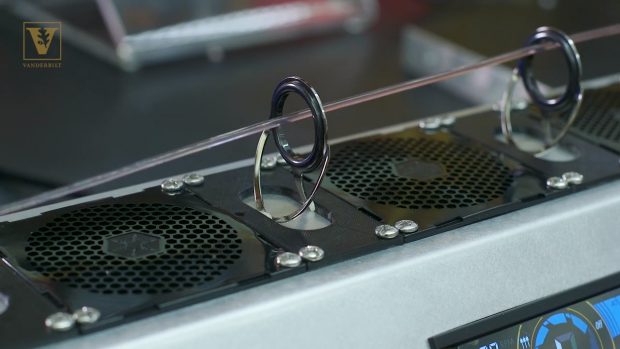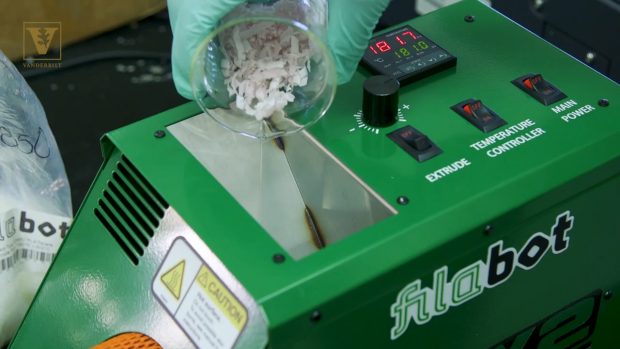Researchers at Vanderbilt University have developed a non-destructive evaluation process that promises to enhance manufacturers’ ability to assess the structural integrity of 3D-printed products. The new testing technique chips away at one of the chief obstacles keeping additive manufacturing (AM) from taking on more demanding applications in the automotive, aerospace and medical equipment industries.
 An interdisciplinary team of researchers at Vanderbilt University has developed a technique that uses the optical properties of gold nanoparticles to detect and quantify missing layers in 3D-printed products. By scanning light across the surface of a printed object, engineers can identify defects in that material. Image courtesy of Vanderbilt University.
An interdisciplinary team of researchers at Vanderbilt University has developed a technique that uses the optical properties of gold nanoparticles to detect and quantify missing layers in 3D-printed products. By scanning light across the surface of a printed object, engineers can identify defects in that material. Image courtesy of Vanderbilt University.Quality Control Challenges
The new testing technique seeks to provide the means to identify defects during the manufacturing process. Missing print layers and other material defects arise from a variety of fabrication complications, ranging from a clogged print nozzle to underextrusion during the printing operation. If left undetected, defects reduce the overall strength and performance of as-printed parts and materials, and can result in premature material failure. The ability to detect and identify these flaws will mark a crucial step in the drive to incorporate quality control metrics into AM processes.
Developers of AM technology have introduced a number of techniques aimed at assessing the integrity of the highly complex geometries of printed parts and materials. These include ultrasonic inspection, impedance-based monitoring, and thermography supported by image correlation.
Although these methodologies provide insight into the quality of the printed object—offering their own set of advantages and disadvantages—no one approach has achieved dominance within the 3D printing sector. The continued advancement and development of new technologies that can help enable inspection and quality control metrics are still needed to realize broad industrial adoption of AM technologies.
A New Approach
This is where the technology developed by Vanderbilt University’s research team comes into play. The scientists have created a technique that uses the optical properties of embedded gold nanoparticles to detect defects in printed products.
The multistep process begins by mixing and extruding gold nanoparticles and the polylactic acid polymer host matrix. Currently, the researchers add less than 0.5% by weight of gold nanoparticles to the host matrix to achieve the desired sensing application. The mixture is dried and then shredded to obtain small plastic pellets containing gold nanoparticles.
After a part is printed, it is inspected by a special ultraviolet-visible spectrophotometer for defects. The scientists contend that the process can detect defects invisible to the eye.
“Parts printed with the “nanofunctionalized” filament are unique in the fact that the sensing capability is embedded directly within each print layer and throughout the entirety of the part,” says Cole Brubaker, a member of the Vanderbilt research team and lead author of the paper “Nondestructive Evaluation and Detection of Defects in 3D Printed Materials Using the Optical Properties of Gold Nanoparticles.” “Once a part has been manufactured, we can run a quick nondestructive test, where light is passed across the surface of the material to illuminate regions of defects within the final 3D-printed structure.”
Overall, the synthesis of gold nanoparticles is a relatively straightforward process. All of the equipment used in the fabrication and printing process is commercially available. For the research team’s bench top set up, they use a Filabot extrusion and spooling system and an Ultimaker 3 3D printer. Depending on any upgrades, the complete system could be obtained for around $10,000.
The Optics of Defect Detection
The core of this inspection technique lies in the optical properties of the gold nanoparticles. In this process, the microscopic matter generates a “signal” that provides information about the state of the 3D-printed material. This approach is an extension of Beer’s law, which states that for any nanoparticle solution there is a linear relationship between absorbance intensity and concentration of nanoparticles for a given path length. This means that when the concentration of nanoparticles increases, absorbance intensity also increases.
“In our case, instead of changing the concentration of nanoparticles, we monitor changes in path length or overall material thickness,” says Brubaker. “Because the gold nanoparticles are embedded throughout the printing process, when there is a defect in the printing process and no material is deposited in a specific area, absorbance decreases due to the lack of nanoparticles.”
Missing Layers
3D printing defects come in a variety of forms, ranging from gaps in the print to overhangs. The Vanderbilt researchers’ technique focuses on one of the greatest problems: missing print layers. “Using our approach, defects as small as 0.1 mm—roughly the thickness of a single sheet of paper—can be identified and quantified,” says Brubaker.
Work on the embedded gold nanoparticle technique, however, is still in the early stages of development, and the researchers envision a number of other relevant applications, where the technique can be used to enable enhanced sensing and monitoring within in-service 3D-printed parts.
What’s Next?
The AM industry has experienced significant growth over the past decade. Academia and industry have begun to adopt 3D printing for a wide range of applications. For the technology to be adopted on a large scale, however, it must be able to consistently deliver high-quality, as-manufactured parts.
“Beyond defect detection, the development of gold nanoparticle functionalized filament represents a promising direction for how we can think about the additive manufacturing process as a whole,” says Brubaker. “By focusing on the end use, we can begin to tailor material systems to provide enhanced properties and functionalities that wouldn’t otherwise be present in the unmodified material. Not only does this include defect detection but also in-service monitoring, enhanced material strength and durability, and chemical and thermal resistance. The possibility of materials design for additive manufacturing will only continue to grow as additional fields and industrial processes begin to adopt the technology for larger-scale production of functional, end-use products.”
Source: Vanderbilt University
About the Author
Follow Robotics 24/7 on Linkedin
Article topics
Email Sign Up
















